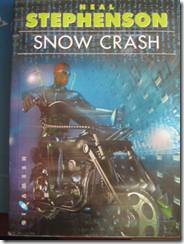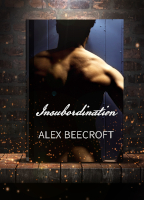Ten things review of Snow Crash by Neal Stephenson
Guess what I’ve just finished reading? I suspect it’s a classic that I ought to have read earlier. Certainly if I’d read it when it first came out in the nineties many of the things in it that reminded me of stuff I’d seen elsewhere, or mundane every day realities, would have seemed like dazzlingly weird imaginings. Some of the gloss is taken off, now that we’re living with things like 2nd Life and Google Earth, which would have been intact when yahoo groups were the most complicated thing on the internet.
Anyway, ten things. Five good, five bad:
Good:
1. This is the very definition of high concept. It bursts at the seams with new ideas, and even though reality has caught up with some of those new ideas now, you can still hear them sizzle.
2. Sumerian neuro-linguistic programming. Seriously, I luuurve almost all stories that hinge on forgotten technologies of ancient civilisations that look like magic to us now. I was going “oh, stop with the swordfighting and get back to talking about Babel and Asherah and the nam-shrub of Enki.” I need to find excuses to get the phrase ‘the nam-shrub of Enki’ into every day conversation.
This is the high concept thing again, but the nam-shrub of Enki gets its own entry, because the idea of there once existing a language that bypassed all the higher functions of the brain and moved people to act the way computer programming causes computers to act, is a delightfully new one to me. I knew of the idea of a primal language, of course, but the idea that it would work like programming on people was fascinating.
3. Good doggies. I loved the rat things, even if they reminded me of the metal dog in The Ballad of Halo Jones. I don’t know which came first, but I loved both – so it’s all good.
4. Everyone is a character of colour – and this was first published in 1992.
5. Gated communities turned into independent countries, and run as franchises by enterprising individuals like Uncle Enzo of the Mafia and Mr. Lee’s Greater Hong Kong. It’s a fun idea and doesn’t actually sound too impossible.
Bad:
1. (But appropriate) The characters are as flat as video game characters – they don’t have personalities other than their skills and appearances. These are designed to be cool, but they give off a ‘so desperate to look cool they just look like sad posers’ vibe to me.
2. Far too much ‘Look at all the hard edged urban crime-war grittiness! Isn’t it exciting?” for me. Possibly I’m just over-exposed to American urban crime-war grittiness as a genre, which would not have been such a problem when it first came out.
3. So YT’s mum gets interrogated by the Feds and reveals that she knows of the existence of a drug that can scramble the brains of programmers just by looking at a bit map. There’s lots of heavy angst and foreshadowing around this. And then nothing happens, and when YT gets home from being kidnapped, her mum’s there, apparently unharmed and unaware that her daughter has been missing for months, and everything’s back to normal? Does not compute.
4. Raven is the coolest badass ever to badass, and I suspect we’re supposed to think it’s glamorous and/or attractive, but actually it’s just the most extreme case of ‘my author thinks I’m hot, so you should too,’ I’ve seen in quite a while. Actually this goes for the hero, Hiro, too. I can’t take seriously anyone who calls himself ‘Hiro Protagonist.’
5. How convenient it is that YT discovers she has the hots for Raven, given that it’s pretty clear that she doesn’t actually have the choice to say no to him. It struck me as a nasty case of ‘how to rape your 15 year old heroine and pretend you didn’t,’ and it spoiled any pleasure I might have had in YT’s cleverness. Although the fact that she was passed from hand to hand between all the powerful men in the story for them to patronise and admire for her cute spunkiness didn’t help either.
On balance:
Still seriously worth reading. My life would be so much poorer without the nam-shrub of Enki in it. And having said all the bad stuff, it was still gripping and entertaining throughout. Even the bad bits were not that bad, when weighed against the good.


I read this when it came out. I didn’t like it. The linguistic stuff was very cool, but I would have enjoyed it more in an essay than in fictional form. I read The Diamond Age, too, and the bits about Chinese were so racist I didn’t bother reading anything else by him.
My old roommate is a huge Neal Stephenson fan, and we used to have intense debates, because I’m such a Stephenson hater. My problem with his books is that besides the cardboard characters, the plots are terrible. These books don’t end; they just implode. I also suspect a lot of it comes down to the unique sense of humor. It either gels with readers, or it doesn’t, and it doesn’t for me.
The only book I read by him that I unreservedly liked was an unambitious thriller called Zodiac. There’s a central joke/pen about PCP that I actually thought was hilarious.
The only other one of his I’ve read was Anathem, to which I had similar reactions – his big ideas are fascinating, but his understanding of human nature and his drawing of individuals is nothing to write home about. That was less of a problem in Anathem, since so much of it was about philosophical concepts that it didn’t matter that the humans were interchangeable. And I felt he got away with it in this one because the characters were very video-gameish, which was appropriate to his setting.
I must be so out of touch with his sense of humour, I didn’t even realise that he had one. Were parts of this supposed to be funny?
I haven’t tried The Diamond Age, so I’ll avoid that one on your recommendation.
But yes, the linguistic parts were so much fun. I think I’ve been so starved for big concepts recently that I’m just bowled over by meeting new ideas in books again, after a long time of it all being ‘does he love me or doesn’t he?’ This is an important question, but it’s nice to be reminded that it’s not the only question 😉